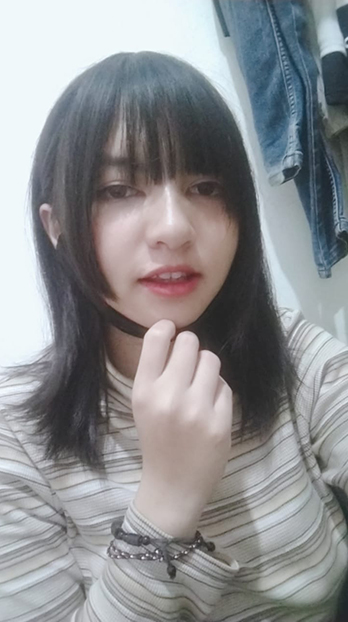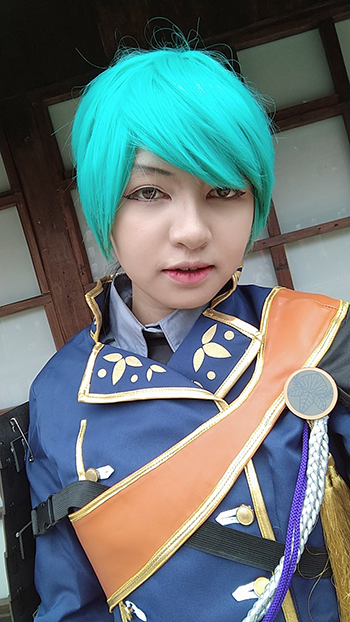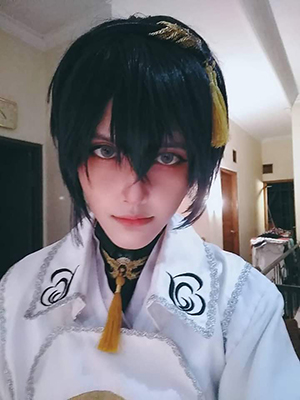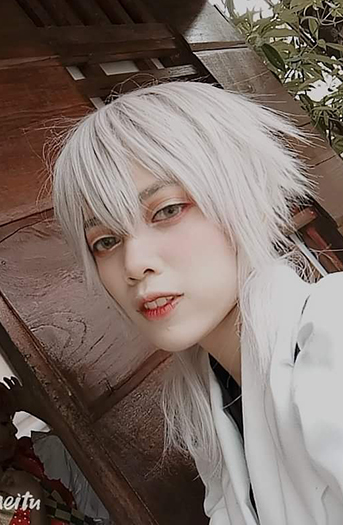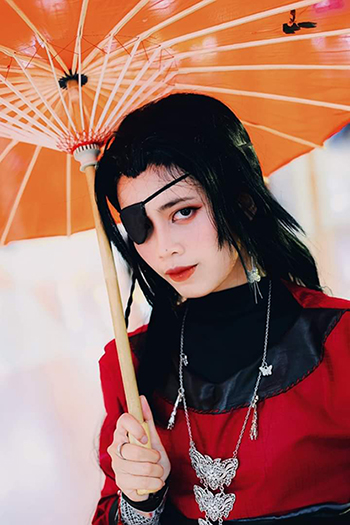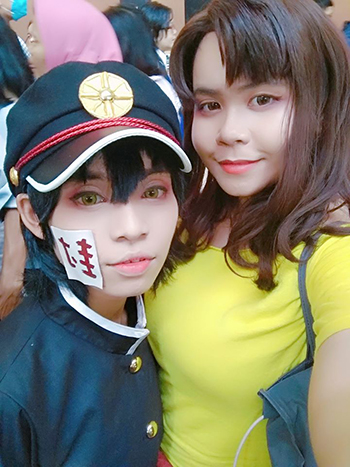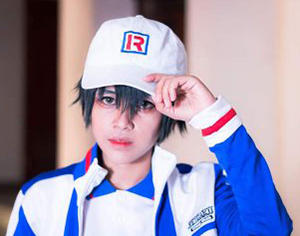|
Intersections: Gender and Sexuality in Asia and the Pacific
Issue 47, July 2022 doi: 10.25911/B9QB-7P82 |
|
Performing Male Identity as Portrayal of Self in Bandung Crossplaying Landscape Asep Achmad Muhlisian, Aquarini Priyatna and Amaliatun Saleha Introduction In recent years, many youngsters in Indonesian cities have been embracing a new hobby of dressing up as characters from Japanese anime, manga, idols and games. This fan practice is commonly referred to as 'cosplay.' A subgenre of cosplay called 'crossplay' has also been popular among the Indonesian cosplay community. In crossplay, the characters are different from their own gender identities ascribed by society. This article specifically addresses female-to-male (F2M) crossplay practised by Indonesian female cosplayers focusing on Bandung, where they costume themselves as male characters from Japanese anime, manga, idol and games. Many scholars have critically addressed cosplay and crossplay with gender performativity raised by Judith Butler.[1] Judith Butler initiated studies on gender performativity and the construction of gender identity. As she argues, gender is formed when the body displays certain gender performativity spontaneously, repeatedly and continuously.[2] A body of research has been conducted on gender performativity, especially concerning cosplay and crossplay. Rahman Osmud conducted other research regarding the reasons and experiences of cosplayers in Hong Kong.[3] The results show that cosplayers enjoy their activities because they can 'escape' from their real lives for a moment by roleplaying as fictional characters. Unlike cosplay, crossplay requires performers to explore roles by imitating the traits of characters of a different sex. Nicholle Lamerichs, who examines cosplay among anime fans in Europe, asserts that gender performativity in cosplay is more explicit crossplay, which can be seen as a combination of drag and cosplay.[4] Taking M2F (Male-to-Female) crossplayers as its subjects, Rachel Leng's study deals more specifically with the effect of crossplay on communities performing cosplay as popular culture in North America.[5] In Leng's observation, the M2F crossplay performance process expands from four basic components, namely clothing, makeup, (anime) character, and photos. Crossplaying refers to both M2F and Female-to-Male (F2M) characters.[6] Examining a cosplay community in Australia, Craig Norris and Jason Bainbridge argue that for anime and manga fans, cosplay is not merely a practice of identification, alignment and belonging. They suggest that cosplay can be a site in which socially and culturally constructed ideas about the meaning of being masculine and feminine are problematised.[7] Furthermore, Emerald King argues that the issue of crossplay in the Australian cosplay community is unavoidable concerning the (re)production and performance of BL (Boys Love) narratives.[8] As most Australian cosplay practitioners are women, as is the case in many cosplay communities worldwide, cross-dressing, attitudes towards cross-dressing and the act of cross-dressing itself, cannot be ignored when discussing BL and cosplay.[9] Afriat Liron introduces a new hybrid between cosplay and queer Japanese popular culture in Israel.[10] This is when some cosplayers began engaging in casual cosplay for meetups and conventions based specifically on queer Japanese manga, anime, and games, primarily BL and its female-female counterpart. Cosplay and queerness are also discussed by Maud Lavin in relation to Mainland China, Hong Kong, and Taiwan.[11] While Lucy Glasspool argues that fans in different regions adapt cosplay and BL for their specific purposes.[12] In South Asia and India, BL cosplay is a 'safe' space to envisage sexual desire without female bodies being highly policed , while in South Korea, BL cosplay has a close connection with K-pop fandom. Recently fans have begun to engage with LGBTQ issues. In Indonesia, several studies examine the relationship between BL and cosplay such as those by Putri Andam Dewi[13] and Kania Arini Sukotjo[14] who researched the Fujoshi community or women who are fans of BL manga. They argue that Fujoshi is also often cosplay because they use their favourite BL character and crossplay. However, although crossplay has begun to develop among the cosplay community, especially in Bandung, it does not necessarily make crossplay actors comfortable when talking about BL. Because BL is very closely related to sexuality and homosexuality some crossplayers are hesitant to discuss it especially with people outside their community. One of the respondents named Nagi said, 'Uhm it's uncomfortable to talk about, we usually talk about BL if we're in the same circle hehe …' Sukotjo has explained that homosexuality as a whole is considered sinful by the majority of Indonesians who follow the religion of Islam. Islam teaches homosexuality is a sin.[15] Indeed it is very difficult to contradict the religion's teachings and this makes the crossplayer uncomfortable when speaking about BL and yaoi. In this research, we do not discuss the connection of crossplay with BL and yaoi in detail. Instead, we focus more on male identity that is shown in F2M crossplay. That said, in this article, we examine gender performance by Female-to-Male (F2M) crossplayers. In addition, we also explore whether the gender role performed by crossplayers in the Bandung cosplay community correlates with their gender identity in daily life. Cosplay and crossplay: Japanese popular culture in Indonesia In the wake of globalisation and technological advancements, the cosplay culture has become increasingly ubiquitous.[16] As a form of Japanese popular culture, cosplay brings to reality the realms of fantasy that are portrayed in anime, manga, idol and video games.[17] The term cosplay or kosupure in Japanese is derived from the Japanese words 'costume' 「コス」 and 'play' 「プレ」.[18] It is a type of performance art in which individuals dress as fictional characters from, usually, graphic novels, comics, cartoons, games, or the science fiction/fantasy media. Cosplay became popular in Japan at the Comic Markets in the 1980s, possibly after having been brought back by Japanese fans who had visited a convention in the United States a few years earlier. In North America, the specific practice of fans dressing up as their favourite characters dates back to 1939, when the first World Science Fiction Convention (Worldcon) was held in New York City.[19] However, the term 'cosplay' was coined by a Japanese anime producer, Takahashi Nobuyuki, after attending a science fiction convention in the United States in 1982.[20] By the end of 1990, cosplay had become a form of fan practice that was increasingly popular in many parts of the world. Cosplay has long been associated with Japanese popular culture such as manga, anime, idols and games since these fans practice performance art.[21] Unlike general fans, cosplayers attend conventions in elaborate costumes and makeup as they bring fictional characters to life. In Indonesia, the cosplay phenomenon first emerged when Japan initiated good relations with the Republic through cultural diplomacy in the form of manga and anime, in the late 1970s. Since then, cosplay has grown into a very popular hobby that is fancied by teenagers and adult communities. The different abilities in cosplay make it a creatively challenging hobby. It is essential for enthusiasts of the hobby to study their characters, so they can apply appropriate makeup and create suitable costumes. This is the reason that many teenage cosplayer hobbyists have joined cosplay clubs or communities.[22] In Indonesia, cosplay communities began to rise, especially in big cities like Jakarta, Bandung and Jogjakarta. The Bandung Cosplay Community is a pioneer of cosplay activities in Bandung. Akuy, the Bandung Cosplay Community coordinator, claims that the community started in 2005 following the boom of Japanese films and comics in Indonesia and cosplay became the forum and medium through which people can express their passion for Japanese anime. In response to the growing enthusiasm for cosplay, the Bandung Cosplay Community was formed in July 2008. With a membership of over 2,000 people, the community has been running regular activities. In 2011, anime costumes dominated Bandung's cosplay scene. People dressed as characters from the anime Naruto series and the Korean online game Ragnarok could be seen in cosplay crowds. In 2012, however, the trend started to shift toward an identifiable Indonesian style, but without abandoning the original Japanese cosplay elements. As the community grew, many of its membership prefer crossplay to cosplayand this later development was marked by the emergence of what became a sub-type called crossplay.[23] In crossplay, players appear as characters of a different gender.[24] Crossplay can be performed not only by crossdressing but also by getting into and acting out a role as well as by wearing makeup. In crossplay, the performers are called crossdressers or crossplayers. There are different reasons why cosplayers perform crossplay. While some may want to show another side of their identity that is contrary to the prevalent gender norms, others wish to express strong fondness for certain anime characters. We will eventually dwell upon this by focusing on the members of the Bandung Cosplay Community. Gender performativity Butler has explained the connection between gender and sex by presenting the concept of gender being a 'show' or 'performance.'[25] Butler's main idea covers gender and sex performativity. Gender, and even sex, for Butler is a 'show,' and not the essence or expansion of sex in the body.[26] According to Esther Newton, as quoted by Moh Yasir Alimi,[27] gender is formed through impersonation. Impersonation is imitation, with all its attributes and characters. Butler prefers to use the word 'imitation' rather than 'impersonation.' She argues that gender and sex are not 'substantive metaphysics.' They are, rather, attributes formed through performance or performativity. The purpose of gender/sex is to achieve heterosexuality and sexuality for reproduction. Coherence hides gender multiplicity and gender and sexuality discontinuities. Butler, affirms that gender is a performance or gender performativity.[28] The theory of gender performativity, according to Butler, concerns the formation of gender when the body performs certain gendered performances. Body performance is repeated, improved, and strengthened continually to define sex and gender as either male or female. Butler argues that performative factors influence the formation of identity through discourse. These identities do not necessarily emerge or appear in a society but are formed through performance, namely the repetition of actions and practices that are socially accepted as markers of men's and women's identities.[29] These gender identity markers are often called gender acts.[30] Gender performativity implies that each individual forms a specific gender identity. Also termed corporeal style, one's specific gender identity refers to anything that is attached to the body and is sustained socially. According to Butler, the constant repetition of specific actions, styles, and expressions shape what we know as 'femininity' and 'masculinity,' women, and men.[31] Masculine male identity is marked not only by one's sexual organs or genitalia,[32] but also by a square jaw, broad chest, broad shoulders, brawny, muscular definition, and the manual or physical job that one does, all of which are considered to constitute manhood or masculinity.[33] What gender performativity implies is that what we take to be the internal essence of gender is produced through a series of sustainable actions. As an essential part of the influence of the Japanese popular culture in Indonesia, especially in Bandung, crossplay exemplifies the performativity of gender. Negotiating the boundaries Cosplay is a process of converting a two-dimensional (2D) image from a page of manga, anime, or any 2D character to a three-dimensional (3D) living character in real time. Cosplay provides young people with dreams, pleasures, romances and fantasies that cannot be fulfilled or cannot materialise in their daily lives.[34] According to Susan Napier, it is evident that crossplaying provides performers with a momentary escape from the stresses and monotony of ordinary life; and allows them to enter into a whimsical dream of fantasy or childhood.[35] Participants are constantly exchanging and negotiating the boundaries between what is '"real'" and what is "'fantasy".'[36] In other words, the identification of the crossplayers is not stagnant; it often shifts and evolves with time without a fixed boundary. Alternatively, the reality show is a process of transforming dreams, ideals or fantasies into a physical reality. Indeed, enthusiasts are often in the process of challenging and negotiating the normative tenets of the state. It would be interesting to explore the relationship between reality and fantasy in the context of crossplay. Research method In this ethnographic study, the research subjects were selected based on Abdul Halik's[37] pragmatic and theoretical principles. To select the subjects and determine the population required for the study, questionnaires were distributed to visitors at two Japanese cultural events in Bandung, requesting their consent to participate as research subjects. The first event was Japan Zuki,[38] organised by the Japanese Language Department of Indonesia University of Education on 6–7 April 2019. Initially, we found it difficult to obtain participants for our study at this event because only ten cosplayers, among whom there was only one crossplayer, signed in for the concurrent cosplay contest, which went under the theme cos-walk.[39] However, it turned out that other than the ten cosplayers, there were quite a few visitors performing cosplay on the street or what our research subjects called costreet[40] at the event. We found five costreet performers performing F2M crossplay characters, two of whom consented to becoming informants. In the second event, Yamato Damashi XIV,[41] held at STBA Yapari ABA Bandung on 22 September 2019, we obtained consent from three more F2M crossplayers. Details about the five informants are provided in Table 1. Table 1. Research Subjects from Bandung
The five informants are aged between nineteen and twenty-nine years, come from different f professions, and are all members of Komunitas Cosplay Bandung (Bandung Cosplay Community). In this article, the respondents are referred to by the stage names they use when crossplaying. Using a quasi-ethnographic method, this study made use of several Japanese cultural events attended by crossplayers. That way, it was easier to interview the respondents and obtain thorough information about the processes involved in crossplaying. By attending crossplay events, the researchers themselves were able not only to make close observations of the detailed activities performed by crossplayers but also to obtain relevant visual data in real time.[42] Crossing boundaries: Performing male identity in crossplay F2M From our interviews, we found that F2M respondents explained that crossplaying enabled them to portray male identities that are unique and unlike the original forms of masculine identity. According to Gita Noviasari, masculine identity is traditionally recognised based on traits indicating manly males, who are dependable, muscular, hardworking, square-jawed and broad-chested.[43] However, over time masculine identity has shifted to the image of tall, slender, white-skinned, neatly dressed, gaunt-jawed, slanted-eyed, and sharp-nosed males. In F2M crossplay, characters may also be active, quiet, childish, sweet, and funny similar to characters in animation. In this study, we found that three characters are idealised as masculine men in the realm of anime, manga, and idols. They are ikemen, bishounen, and shouta. These three 'types' are defined below. The first informant is Hikari, a twenty-year-old university student in Bandung. She has been actively cosplaying since 2013 but started crossplaying in 2016 performing the characters of Ichigo and Sanehada, which appear in the game and animation of Touken Ranbu. Hikari often posts photos of herself on her social media under the name of Hikari Aotsugi. In this paper, all the informants will be referred to by their stage names. Cosplayer 'Hikari' explained to us that, 'I like the crossplay character because I want to be handsome; I want to be ikemen who is handsome, cool, and pleasant-looking.'[44] Her desire to be handsome correlates with the depiction of the physical form of a male and is similar to Ikemen.[45] Ikemen is derived from two Japanese words: ikeru or iketeru and menzu, the term ikemen refers to a metrosexual style. The word ikeru or iketeru is an abbreviation of cool. The word menzu means man. Therefore, ikemen refers to men who are sexy or handsome or neatly dressed.[46] Hikari mentions a tall body, oval face, small eyes, sharp nose, and pointed chin as typical physical features of the ideal masculine body, or ikemen. To resemble the ideal face and body shape of her favourite character, Hikari must modify her face until she is satisfied with her appearance as that character. To maximise the masculine character and mask the attribution of woman in herself, Hikari, who has a round face, tries to smooth or taper her cheek by sticking strips of face tape from under her cheeks toward her neck.[47] To help shape her eyes, Hikari sticks a strip of face tape on both temples to pull up the skin and make her eyes look smaller and sharper. She then applies makeup. The chest is a female attribution that has to be modified or covered when an F2M crossplayer presents herself as a male character. In an attempt to hide her breasts, Hikari uses a chest binder to flatten her chest.[48] To make her shoulders look wide, she uses foam as a booster. After modifying her body into what she perceives is an ideal masculine male character, Hikari also wears a costume similar to the depiction of his character in the anime (see Figures 1 and 2).
Figures 1 and 2. Hikari's crossplay costume as Ichigo of the anime and the game Touken Ranbu at the event held at the Great Asia Afika Bandung (2019) Source. Photo taken from Hikari's personal documentation, and reproduced here with Hikari's permission. The second informant, a twenty-two-year-old, Bandung-based freelancer, uses Samael or Sam as a stage name. Sam has been actively crossplaying since 2010. Sam not only appears in crossplay events but also poses in photo sessions. Sam is well known as Smile Eldritch on social media. She often performs the character Shimotsuki Shun of Idol Tsukiuta. Samael explained to us:
Otome is a category in Japanese games that are marketed to women. An otome game can be briefly defined as a game that features romance or dating simulations.[50] Outside Japan, many otome game players use characters from anime when playing the game. Most otome gamers are female and many of them also play male characters. Samael likes otome games and often plays ikemen male characters in otome because she feels that her body, especially her shoulders, is more suitable for performing male characters than female characters (see Figures 3 and 4). The social construction allows male bodies a larger space to move.[51]
Figures 3 and 4. Samael performing crossplay as Shimotsuki Shun and Uzuki Arata in the Idol Tsukiuta, and reproduced here with Samael's permission. Source. Photographed by Replica, 'Samurai Project' online: www.facebook.com/photo?fbid=10211886138029030&set=t.1838473316, accessed 22 September 2019. Other characters are idealised as masculine men in the realm of anime, manga, and idols the term used to describe them is bishounen. Bishounen holds the concept of the androgyne, and is described as a man with long hair but is sweet, slender, elegant, clean-faced, and big-eyed.[52] We identified the bishounen character in the third informant who uses Nagi as a stage name. She is nineteen years old and has been performing crossplay since 2014. Her favourite characters are Tsurumaru Kuninaga of Anime and Game Token Ranbu and Hua Cheng of a Chinese novel. Nagi explained: 'I play Tsurumaru because he is a handsome and unique character. However, I think that it is his personality that makes me choose him. Tsumaru is annoying and handsome character.'[53] Bishōnen is a Japanese word that means 'beautiful man' or 'very feminine male character' who is tall with robust angular facial features.[54] The more dominant bishounen character appears in Nagi's crossplay costume because her gentle facial posture and attitude are the appropriate attributes presented in bishounen characters (see Figures 5 and 6).
Figures 5 and 6. Nagi Crossplaying as Tsurumaru Kuninaga of the Anime Token Ranbu, and Hua Cheng of a Chinese Novel, at the First Warriors Event held at Istana Plaza Bandung (2019) and reproduced here with Nagi's permission. Source. Photographed by Suwitno Adi, online: www.facebook.com/photo.php?fbid=2558505580884728&set=t.100001759331809&type=3 and www.facebook.com/photo.php?fbid=2492568604130735&set=pb.100001328601210.-2207520000..&type=3, both accessed 12 Dec. 2019. The next informant is twenty-four-year-old Naruma, who has been crossplaying since 2013. She often performs as a character named Norman from the anime Yakusokuno Neverland and Hanako Kun of the anime Jibaku Shonen. Naruma often plays the characters of Norman and Hanako Kun because their visual depiction does not seem to match their traits of character. According to Naruma,
Shouta is a term used commonly for boys. Shouta (or shoutakon), abbreviated from Sh?tar? complex is, in Japanese contexts, the attraction to young (or young-looking) boy characters, or media centered around this attraction. The term refers to a genre of manga and anime male characters are depicted in a suggestive or erotic manner.[56] In the Bandung crossplay community, a character called shouta depicts the characters of children in anime or manga, who are funny, sweet, and tend to be bishounen. With a height of about 149–150 centimetres, this character highlights the attributes of a child's body, namely small, and cute. In Naruma's view, a shouta character can represent her desire to put on a cross-gender performance in crossplay. Based on Naruma's description, the typically not-very-tall nature of a shouta character suits her 148-centimetre height. With her stature, she admits, she always tries to find a character of an approximate height. She adds that she prefers characters who have a cheerful disposition and a child-like countenance with large eyes and a clean face. Her preference seems to lean toward the bishounen that are often portrayed in anime. Shouta is, for Naruma, a type of character that can best represent a masculine gender identity while masking her female attributes (see Figures 7 and 8).
Figures 7 and 8. Naruma Performing Crossplay as Norman of the Anime Yakusokuno Naverland, and Hanako Kun of the anime Jibaku Shonen. Source. Photographed by Dimas, 29 Mar. 2020 for personal documentation, and reproduced here with Naruma's permission. Naruma is our final informant and she uses Akito Shion as her stage name. The twenty-nine-year-old woman is an employee and has been crossplaying since 2012. The characters she plays most often are Ryoma Echizen of the anime Prince of Tennis and Kagehira Mika of Idol Ensemble Stars. She likes short male characters, popularly known as shouta and tries to embody them visually in her appearances. Akito does her own makeup because she feels that performing as a male character requires a more straightforward makeup style, except for the eyes. After all, shouta characters are usually big-eyed, while ferocious shouta characters are narrow-eyed. Many aspects must be considered when using makeup, especially the eyes. As for the chest; Akito always binds her chest, especially when wearing a small-size or tight costume. Sometimes, Akito prefers to wear a big-sized jacket that covers her chest (see Figures 9 and 10),
Figures 9 and 10. Akito Shion crossplaying as Ryoma Echizen of the anime Prince of Tennis, and Kagehira Mika of the Idol Ensemble Stars Sources. Ryoma Echizen of the anime Prince of Tennis, photographed by Nekoyaki, 24 Dec. 2015 for Akito's personal documentation. Kagehira Mika of the Idol Ensemble Stars, photographed by Feiy, 16 Apr. 2020 for personal documentation and reproduced here with Akito's permission. In the process of the gender performativity as F2M crossplayers, the five respondents show, depict and shift masculinity that is identified with normative men. F2M crossplaying enables them to portray male identities that are unique and unlike the original forms of masculinity. Therefore, the crossplayers have shown new forms of identity with their bodies, and transformed their physical forms into their own standards to shape their traits.[57] When displaying a character, an F2M crossplayer will do their best to match the character. The crossplayer usually searches for and identifies characters that are close to her nature and character.[58] Lamerichs defines crossplay as an exchange of mutually beneficial characters.[59] A crossplayer identifies aspects of the character to play, and the character influences the surroundings. For Lamerichs, when someone performs crossplay, it is an actualisation of his or her own identity in gender expression through crossdress, and the narration or character related to the crossplayer is a statement about themselves. So, they find it difficult to portray characters other than those they have been engaged in portraying, as it is not easy to throw away the costumes and to learn new traits and new makeup styles. Our five respondents always try to find characters that have physical characteristics close to their traits. For crossplay performances and photo sessions, they are easily able to adjust and further maximise their characters by manifesting their ideal attributions through the essential components of costumes, makeup and character development. There is a process involved in an F2M crossplayer that maximises those attributions that supposedly represent masculine gender identity. At this phase, the relationship between bodily representation and masculine identity must be be considered as a form of what Butler calls gender performance, which shows that male attributions to masculine identity can be exchanged and not based on the concept of men in general. The process of an F2M crossplayer maximising attribution is the optimal representation of masculine gender identity and the masking of feminine attributions. It is the repetition of actions and practices that are accepted socially as a marker of male identity.[60] Negotiating gender identity from fantasy into reality F2M crossplayers say that they perform roles according to the characters they prefer and this performance is to fulfil things that do not exist, or they cannot do in real life. As one crossplayer, Hikari, explained: 'I want to be handsome because I love seeing handsome guys. Then, I decide to be a handsome guy myself, so I do not have to wander off to find handsome guys.'[61] Hikari's statement shows that so far she has not found a handsome male form that fits her criteria in real life, so she attempts through her performances to bring a handsome male character into the real world by crossplaying as a male. Other motivations appear to be related to the body, such as Sam's statement,
Sam sees her physical body condition with wider shoulders as resembling a man's body and thus making her more comfortable performing a male character. Naru stated,
Confidence is a complicated problem for Naru. In everyday life, she is not confident because she is not comfortable with her physical body, especially when photographs are being taken. However, by performing as a male character she becomes more confident and more comfortable and this builds her confidence when she is being photographed. Nagi stated,
Nagi's motivation arises from the fact that she wants to perform a F2M a character that she would like in the real world because she is not feminine in her daily life and doesn't like female characters. This she realises in crossplay. In addition, her desire to meet a male character she would like has not been be realised in the real world, so she tries to make it happen by doing crossplay. Akito declared,
Akito in her daily life wears a hijab and is very uncomfortable when cosplaying as a woman wearing short skirts and in an open costume. Consequently, she chooses to do crossplay so that she can wear a more closed costume that covers her body so that there is no sexual harassment from men who want to take pictures with her. From the respondents' opinions and their initial motivation to perform crossplay, it is obvious that the crossplayers in Bandung use a variety of characters to fulfil their desires for something and to transform their imagination into reality. In addition, whether they realise it or not, they become accustomed to using crossplay attributes when living their everyday lives. These include stage names, parts of costumes and make-up, as well as crossplay characters. In relatin to theis issue, Nagi gave responses such as,
… I usually wear cosplay pants to campus, then I wear t-shirts, jeans, sneakers and walk with my legs slightly open hehehe. If I'm not cosplaying anymore, I don't really like girls' makeup either, so I think it's easier to get into a male character.[66] This shows how Butler's theory of gender performativity concerns the formation of gender when the body performs certain gender performances. Body performance is repeated, improved, and strengthened continually to define sex and gender as either male or female. Butler argues that performative factors influence the formation of identity through discourse. These identities do not necessarily emerge or appear in society but are formed as performances, namely the repetition of actions and practices that are socially accepted as markers of men's and women's identity.[67] As explained above, gender identity is an individual's sense of being masculine, feminine, a combination of both, or neither and it is socially constructed, yet it still pertains to an individual's sense of self. It is not only about how a person perceives their gender but also about how that individual presents their gender to the public because gender identity helps individuals determine their expressions of gender. The process of the five F2M crossplayers in Bandung shows how images shift towards masculinity by maximising attributions, supposedly performed in an effort to represent masculine gender identity in the public space, in the form of gender performativity. Furthermore, F2M crossplay is one form of gender performativity. It is also an avenue via which unfulfilled desires or expectations can be fulfilled. Crossplay enables the imaging of the body into a form of ideal identity transformation: for example,from woman to man in F2M crossplay. Crossplay allows players to imagine their desires, by blurring or even erasing boundaries between fantasy and reality. By portraying men, the F2M crossplayers achieve the satisfaction that they do not get in real life; they find what they are lacking and missing in real life and become more confident with the characters they perform than in their daily selves. Conclusion F2M crossplay is an avenue through which individuals can show, picture and change the masculinity identified with the attributions of normative men. This study reveals there are three characters idealised as masculine men in the context of anime, manga, and idols. The three characters are ikemen, bishounen and shouta. In F2M crossplay, gender identities depicted in anime, manga, games, and idols are the yardstick against which to measure how character portrayal is maximised. In F2M crossplay, ideal attributions are manifested through the basic components, namely costumes, makeup and character development, which are what F2M crossplayers aim to achieve. The process through which an F2M crossplayer maximises her ideal attributions is a representation of masculine gender identity and the masking of her female attributions. In our study, all five informants carry out gender performativities in the form of crossplay by referring to the essential components formerly mentioned. Each informant demonstrates a unique motivation so that she achieves satisfaction, mainly due to her interest in the anime, game, or manga characters that she performs in F2M crossplay F2M crossplayers negotiate the boundaries between fantasy and reality by bringing figures who are considered ideal men in the fantasy world into reality to fulfil the desires or expectations that they find unfulfilled in real life. Hence, F2M crossplay becomes a form of identity transformation from women to men. F2M crossplayers can harmonise their imagination and desire in such a way that blurs or even erases the boundaries between fantasy and reality. Notes [1] Craig Norris and Jason Bainbridge, 'Selling Otaku? Mapping the relationship between industry and fandom in the Australian cosplay scene,' Intersections: Gender and Sexuality in Asia and the Pacific 20 (Apr. 2009), online: intersections.anu.edu.au/issue20/norris_bainbridge.htm, accessed 10 Jul. 2022; Rahman Osmud, Liu Wing-Sun, and Brittany Hei-man Cheung. '"Cosplay": Imaginative self and performing identity,' Fashion Theory 16(3) (2012): 317–41, doi: 10.2752/175174112X13340749707204; Nicholle Lamerichs. 'The cultural dynamic of doujinshi and cosplay: Local anime fandom in Japan, USA and Europe,' Participations 10(1) (2013): 154–76; Rachel Leng, 'Gender, sexuality, and cosplay: A case study of male-to-female crossplay,' The Phoenix Papers: First Edition Apr. (2013): 89–110, online: fansconference.org/dRuZ33A/wp-content/uploads/2013/04/Gender-Sexuality-and-Cosplay-by-Rachel-Leng1.pdf, accessed 10 Jun. 2022. [2] Judith Butler, Gender Trouble: Feminism and the Subversion of Identity, New York, NY: Routledge, 2015. [3] Osmud, Sun and Cheung, '"Cosplay",' p. 317. [4] Nicholle Lamerichs, 'Cosplay: The Affective Mediation of Fictional Bodies,' Paper read at the Fan Community & Fandom Conference, Oxford, 22 Mar. 2013. [5] Leng, 'Gender, sexuality, and cosplay.' [6] F2M, female-to-male crossplayers (females costumed as male characters, sometimes abbreviated FtM) are far more common, due to a variety of social and cultural factors. Ada Palmer, 'Let's Cosplay: Crossplay,' TokyoPop, (2007), online: web.archive.org/web/20070421090515/http://www.tokyopop.com/649.html, accessed 10 Jun. 2022. [7] Jason G. Bainbridge and Craig J. Norris. 'Posthuman drag: Understanding cosplay as social networking in a material culture,' Intersections: Gender, History and Culture in the Asian Context 32 (2013), online: intersections.anu.edu.au/issue32/bainbridge_norris.htm, accessed 16 Jul. 2022. [8] BL is an anime and manga subgenre that depicts passionate love between male companions, usually of a sexual nature. BL is a term that came into usage during the latter half of the 1990s, indicating, for the most part, original stories written/drawn by professional writers and found in both shōjo manga and shōjo shōsetsu (girls' novels) issued by established publishing houses. See Kayo Takeuchi, 'The genealogy of Japanese Shōjo Manga (Girls' Comics) studies,' U.S.-Japan Women's Journal: A Journal for the International Exchange of Gender Studies 38 (2010): 81–112, specifically p. 91. [9] Emerald L. King, 'Girls who are boys who like girls to be boys …: BL and the Australian cosplay community,' Intersections: Gender and Sexuality in Asia and the Pacific 32 (2013), online: intersections.anu.edu.au/issue32/king.htm, accessed 16 Jul. 2022. [10] Afriat Liron, 'Queer cosplay in Israel,' Mechademia 13(1) (2020): 171–75, doi: 10.5749/mech.13.1.0171. [11] Maud Lavin, Ling Yang and Jing Jamie Zhao (eds), Boys' Love, Cosplay, and Androgynous Idols: Queer Fan Cultures in Mainland China, Hong Kong, and Taiwan, Hong Kong: Hong Kong University Press, 2017, doi: 10.2307/j.ctt1rfzz65. [12] Lucy Glasspool, 'Gender or sexual ambiguity in cosplay: Japanese youth culture in Asian community,' Nagoya University of Foreign Studies, One Asia Program, 25 Feb. 2019, online: https://www.ucm.es/data/cont/docs/119-2019-03-05-LucyGlasspool.pdf, accessed 16 Jul. 2022. [13] Putri Andam Dewi, 'Komunitas Fujoshi di Kalangan Perempuan Indonesia' (Fujoshi community among Indonesian women), Lingua Cultura 6(2) (2012): 173–82, doi: 10.21512/lc.v6i2.404. [14] Kania Arini Sukotjo, 'Comparative studies of Fujoshi communities in Japan and Indonesia,' PhD diss., National University of Singapore (Singapore), 2020, pp. 18–20, online: www.proquest.com/openview/af9db6920f893c84cd234546c2c0de3a/1?pq-origsite=gscholar&cbl=2026366&diss=y, accessed 16 Jul. 2022. [15] Sukotjo, 'Comparative studies of Fujoshi communities.' [16] Susan Jolliffe Napier, From Impressionism to Anime: Japan as Fantasy and Fan Cult in the Mind of the West, New York, NY: Palgrave Macmillan, 2007. [17] Dyah Ayu Kusumastutik, Idola Perdini Putri and Dedi Kurnia Syah Putra, 'Cosplay as pop-culture's identity: Case study of Lunar Cosplayer Community,' Bandung, International Conference on Transformation in Communication (ICOTIC), Bandung 1 Jan. 2016. [18] Theresa Winge, 'Costuming the imagination: Origins of anime and manga cosplay,' Mechademia 1: Emerging Worlds of Anime and Manga, ed. Frenchy Lunning, 65–76, Minneapolis, MN: University of Minnesota Press, 2006, doi: 10.1353/mec.0.0084. [19] Michael Pollak, 'The beyond-this-world's fair,' New York Times, 2 Apr. 2006. [20] Nicholle Lamerichs, 'Theory stranger than fiction: Fan identity in cosplay,' Transformative Works and Culture 7 (2011), doi: 10.3983/twc.2011.0246; Winge, 'Costuming the imagination.' [21] Lamerichs, 'Theory stranger than fiction.' [22] Ranny Rastati, 'Media dan Identitas: Cultural Imperialism Jepang Melalui Cosplay (Studi Terhadap Cosplayer yang Melakukan Crossdress),' Media and identity: Japanese cultural imperialism through cosplay), Jurnal Komunikasi Indonesia 1(2) 2012: 41–51, doi: 10.7454/jki.v1i2.7818. [23] R. Hlozek, 'Cosplay: The New Main Attraction,' Jive Magazine, May 2004. [24] Winge, 'Costuming the imagination.' [25] Butler, Gender Trouble. [26] Judith Butler, Bodies That Matter: On the Discursive Limits of 'Sex,' London: Routledge, 1993. [27] Moh Yasir Alimi, 'Judith Butler: Gender dan Seks sebagai Pertunjukan' (Judith Butler: Gender and sex as a performance), in Manusia, Perempuan, Laki-Laki pengantar ke pemikiran Hannah Arendt, Seyla Benhabib Judith Butler, Ziba Mir-Hosseini, ed. Yusi Avianto Pareanom, 59–84, specifically p. 59, Jakarta: Komunitas Salihara, 2013. [28] Butler, Gender Trouble. [29] Butler, Gender Trouble, p. 191. [30] Ani Rostiyati, Aquarini Priyatna, 'Punk Women: Culture of Resistance to Normative Gender (Case in Cijambe Ujung Berung Village),' Patanjala: Journal of Historical and Cultural Research 9(2) (2017): 261–76, doi: 10.30959/patanjala.v9i2.2. [31] Butler, Gender Trouble, pp. 178–79. [32] Christiany Juditha, 'Gender dan seksualitas dalam konstruksi media massa,' JURNAL SIMBOLIKA: Research and Learning in Communication Study (E-Journal) 1(1) (2015): 6–15, online: ojs.uma.ac.id/index.php/simbolika/article/view/45, accessed 16 Jul. 2022. [33] Gita Noviasari, 'Tampilan Maskulin dalam Video Klip Super Junior "Mr. Simple" dan "No Other"' (Masculine look in Super Junior's 'Mr. Simple' and 'No Other'), PhD diss., Universitas Airlangga, 2013, online: journal.unair.ac.id/download-fullpapers-comm393e0472cbfull.pdf, accessed 16 Jul. 2022 [34] Osmud, Sun and Cheung, '"Cosplay".' [35] Napier, From Impressionism to Anime. [36] Lawrence Grossberg, 'Is there a fan in the house? The affective sensibility of fandom,' in his The Adoring Audience: Fan Culture and Popular Media, London: Routledge, 1992, pp. 50–65. [37] Abdul Halik, 'Paradigma Kritik Penelitian Komunikasi (Pendekatan Kritis-Emansipatoris dan Metode Etnografi Kritis)' (The critical paradigm of communication research (Critical-emancipatory approach and critical ethnographic method), Jurnal Dakwah Tabligh 19(2) (2019): 162–78. [38] Japan Zuki Show UPI is an annual routine event organised by Universitas Pendidikan Indonesia (UPI), in West Java. See 'HIMABAJA Gelar Japan Zuki Ke-7' (HIMABAJA holds 7th Japan Zuki), ISOLAPOS.com, 7 May 2012, online: isolapos.com/2012/05/himabaja-gelar-japan-zuki-ke-7/, accessed 10 Jun. 2022. [39] Coswalk is an event where participants wear costumes and walk on a stage and perform attractions. See 'Adu Gaya Cosplay dan Coswalk' (Compete for cosplay and coswalk style), JPNN, 24 Dec. 2018, online: www.jpnn.com/news/adu-gaya-cosplay-dan-coswalk, accessed 10 Jun. 2022. [40] Costreet is a term for cosplayers who come to the event with the aim of gathering without joining the competition. See 'Istilah-istilah dalam cosplay (Indonesia)' (Terms in Indonesian cosplay), Clash Live, 14 Jun. 2012, online: www.facebook.com/notes/cosplay-bandung/istilah-istilah-dalam-cosplay-indonesia/10150918525988600?_rdc=2&_rdr, accessed 10 Jun. 2022. [41] Yamato Damashi XIV is an annual event that adapts the bunkasai event aka the Japanese cultural festival that is often held at the YAPARI-ABA Bandung Himade STBA, online: twitter.com/yamadaxiv, accessed 10 Jun. 2022 [42] Eric J. Arnould and Melanie Wallendorf, 'Market-oriented ethnography: Interpretation building and marketing strategy formulation,' Journal of Marketing Research 31(4) (1994): 484–504, doi: 10.1177/002224379403100404 [43] Noviasari, 'Make up as a masculine appearance.' [44] Interview with Hikari, Bandung, 22 Sep. 2019. [45] Ikemen is portrayed as a small-eyed and neatly-dressed man with a delicate appearance. See 'Ikemen and Ikedan: What kind of men prefer Japanese women? Japan Info, 8 Dec. 2019. [46] D. Tsang, 'Ikemen: Effeminacy or the new masculinity of the modern-day Japanese male?' unpublished paper, Pennsylvania State University, 2011; Cherry, Kittredge, Womansword: What Japanese Words Say about Women, Berkeley, CA: Stone Bridge Press, 2017. [47] A 'face tape' is basically a 'band-aid solution to a mature face' to pull back and stretch the skin to create an illusion of a tighter face. 'Is face tape for instant facelift effective? We tell you the truth!' Beautyglimpse, 10 Feb. 2020, online: www.beautyglimpse.com/effective-face-tape-instant-face-lift/, accessed 10 Jun. 2022. [48] 'A chest binder is a rear elastic section of uniform width that extends entirely across the back of the wearer and to which are secured a pair of inextensible sections adjustably secured together at their forward ends to extend around the body at the chest.' See patent application by Eugene Goldstein, 'Chest binder,' US, issued 10 Sep. 1968, online: patents.google.com/patent/US3400710, accessed 10 Jun. 2022. [49] Interview with Samael, Bandung, 22 Sep. 2019. [50] Sarah Christina Ganzon, 'Growing the otome game market: Fan labor and otome game communities online,' Human Technology 15(3) (2019): 347–66, doi: 10.17011/ht/urn.201911265024. [51] Iris Marion Young, Throwing Like a Girl and Other Essays in Feminist Philosophy and Social Theory, Bloomington, IN: Indiana Press, 1990, specifically pp. 137–56. [52] Rizqi Adnamazida, 'Bishounen, cowok cantik tapi bukan gay!' ('Bishounen, pretty boy but not gay!), Merdeka.com, 5 Jul. 2021, online: www.merdeka.com/gaya/bishounen-cowok-cantik-tapi-bukan-gay.html, accessed 10 Jun. 2022. [53] Interview with Nagi, Bandung, 22 Sep. 2019. [54] Norris and Bainbridge, 'Selling Otaku?' [55] Interview with Naruma, Bandung, 23 Sep. 2019. [56] Jurnalotaku.com, 10 Terms Frequently Pronounced by Japanese Otaku, online: jurnalotaku.com/2014/01/22/10-istilah-yang-sering-diucapkan-oleh-otaku-jepang/, accessed 22 Jan 2014. [57] William E. Connolly, Identity, Difference: Democratic Negotiations of Political Paradoxes, Minneapilos: MN: University of Minnesota Press, 2002 [1991]. [58] Elween Loke, 'To be or not to be the queerest of them all: Investigating the freedom of gender performativity within the queer space of cosplay/cross play,' Gender Studies 16 (2016): 11–22. [59] Lamerichs, 'Cosplay.' [60] Butler, Gender Trouble, p. 191. [61] Interview with Hikari, Bandung, 22 Sep. 2019. [62] Interview with Sam, Bandung, 22 Sep. 2019 [63] Interview with Naruma, Bandung, 23 Sep. 2019. [64] Interview with Nagi, Bandung, 22 Sep. 2019. [65] Interwiew with Akito, Bandung, 22 Sep. 2019. [66] Interwiew with Nagi, Bandung, 22 Sep. 2019 [67] Butler, Gender Trouble, p. 191. |

|
